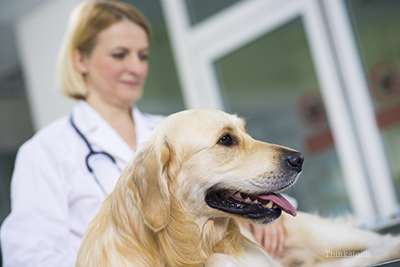
Dr. Phil Zeltzman is a traveling, board-certified surgeon in Allentown, PA. His website is www.DrPhilZeltzman.com. He is the co-author of “Walk a Hound, Lose a Pound” (www.amazon.com).
AJ Debiasse, a technician in Stroudsburg, PA, contributed to this article.
A new concept has emerged in veterinary medicine over the past few years: Fear Free™ veterinary visits. Introduced by Dr. Marty Becker, “America’s Veterinarian,” this concept applies to veterinary hospitals, but you can use some of the concepts to reduce fear in your dog yourself.
Let's face it: nobody truly loves going to go to the doctor. Our dogs are no exception. The trip to your veterinarian is often stressful, for both you and your dog. Stress can cause severe health problems, mask signs of pain or sensitivity, skew diagnostic tests, weaken the immune system and cause diarrhea. Luckily, there are now simple things you can do to make your dog’s visits to the veterinarian less stressful.
Reducing stress before the veterinary visit
Stress starts at home. Dogs who run away when they see the harness or the carrier are actually scared. Make sure your dog gets used to the harness or the carrier prior to visiting your veterinarian. The carrier can be left out and used to play, sleep or eat on a regular basis. Help your dog get used to the collar or the harness and the leash around the house or in the yard.
Veterinary visits should not be the only time your dog rides in the car. You can take him for short rides around the block at first, then increase the distance gradually. This way, your dog will not be fearful of the car. Any anxiety or motion sickness can be addressed with drugs. If needed, your veterinarian can prescribe sedatives (many are natural products), pheromones, anti-nausea medications, compression garments and even special music.
These fear-busting tools can be used alone or together (in what we call a multimodal approach) so that nobody fears a trip to the veterinarian. Dr. Marty Becker calls it, “taking the pet out of petrifiedSM.”
Reducing stress at the veterinarian's office
"Just because" visits to your veterinary clinic can not only reduce stress, but they can help your dog look forward to visiting the veterinarian! Drive to the clinic and allow your dog (after asking for permission) to explore the hospital, meet friendly faces, get some treats and leave. There should be no poking, no nail trimming and no vaccination. Just fun and treats!
During checkups and procedures not requiring sedation or anesthesia, bring your dog hungry: this can work wonders. Bring your dog’s meal or favorite treats along. They can be used as a distraction during the exam, vaccines, blood draws etc. Food or treats should be given until the visit is over. Then a big hug is in order!
Your own demeanor plays a huge role in your dog's comfort. Stress is contagious. Your dog trusts you and senses your emotions, so if you're on edge, your dog will be as well. Do your best not to wear your emotions on your sleeve. Your dog will take cues from you and be on high alert. For example, don’t baby-talk to your dog in the home, in the car or while waiting at the veterinarians’.
Reducing stress after the veterinary visit
Once you've taken your dog home, for example after surgery, there are simple ways to lessen the stress as well.
If your dog was sent home with a plastic cone (E-collar), please leave it on. Taking the cone off and putting it back on is not only annoying, but scary. You may think that it’s stressful to wear this contraption, but it will be far more stress to go through a skin infection or re-stitching an opened incision if your dog licks or chews at the stitches. Most dogs will get used to the cone quickly if you leave it on round the clock.
If your dog gives you a hard time when talking pills, don’t turn this into a big fight. There are treats you can hide pills in. Some specialized pharmacies can “compound” medications into a fun flavor. Not all compounding pharmacies are created equal, so please ask your veterinarian for advice.
Give your dog an opportunity to rest. Just as you need time to recover after an illness or a procedure, so does your dog. The quieter you keep your dog, the quicker the healing. Let your dog sleep!
If your dog requires confinement, keep the location consistent. Use the same crate or the same room. Switching from a room, while you are home, to a crate, when you are out, will make your dog feel as if he is being punished. Spend time with your dog in or near the confined area you chose. Your presence will make him feel like he’s still part of the family. Read a book, watch TV or listen to music with him. It may be a much needed break for you as well.
Follow all aftercare instructions as directed by your veterinarian. These guidelines can help your dog reach a speedy recovery. If no running or jumping is recommended for 8 weeks, then no running or jumping is the rule. Follow-up appointments are not optional. They might include suture removal, bandage changes, follow-up x-rays and progress exams.
We can’t promise that if you follow all of these suggestions, your dog’s experience will be a ride in the park (pun intended). But these tips will for sure minimize your dog’s stress — and yours — to much more acceptable levels.
Questions to ask your veterinarian
- Can we arrange a "just because" visit to your clinic?
- What can I do to minimize fear given my dog’s particular situation?
- Can my dog’s medications be compounded?
If you have any questions or concerns, you should always visit or call your veterinarian -- they are your best resource to ensure the health and well-being of your pets.
